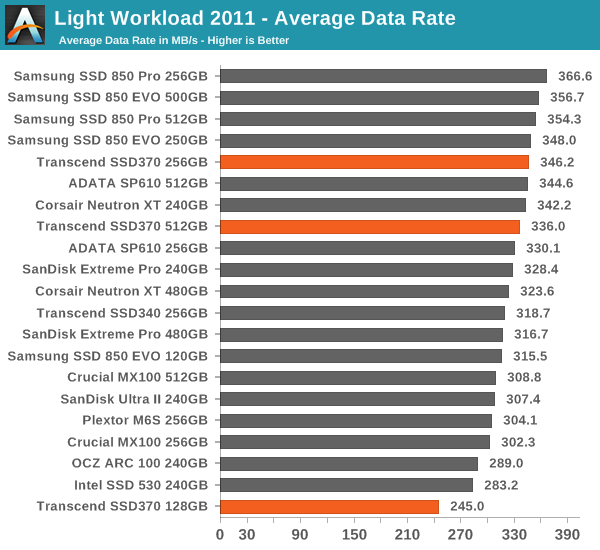Transcend SSD370 (128GB, 256GB & 512GB) Review
by Kristian Vättö on January 27, 2015 8:00 AM EST- Posted in
- Storage
- SSDs
- Transcend
- Silicon Motion
- SM2246EN
AnandTech Storage Bench 2011
Back in 2011 (which seems like so long ago now!), we introduced our AnandTech Storage Bench, a suite of benchmarks that took traces of real OS/application usage and played them back in a repeatable manner. The MOASB, officially called AnandTech Storage Bench 2011 – Heavy Workload, mainly focuses on peak IO performance and basic garbage collection routines. There is a lot of downloading and application installing that happens during the course of this test. Our thinking was that it's during application installs, file copies, downloading and multitasking with all of this that you can really notice performance differences between drives. The full description of the Heavy test can be found here, while the Light workload details are here.

The same story continues in our 2011 Workloads. The performance isn't 850 Pro level, but the SSD370 is competitive among other value-oriented drives. The performance of the 128GB model is a bit of a letdown, but that was expected since 128Gbit NAND has a severe impact on parallelism at 128GB and lower.











44 Comments
View All Comments
danwat1234 - Saturday, January 21, 2017 - link
Might not have been the flash degration, perhaps some other failure. A couple hundred TB before real failure probably. At least 100 I would say. Google this thread "SSD Write Endurance 25nm Vs 34nm" - has extreme testing to failure. But yeah, your SSDs were probably sub 25nm.nathanddrews - Tuesday, January 27, 2015 - link
Has AT ever done anything beyond testing TRIM and provisioning? Are you talking about prolonged write endurance? I think the manufacturer states that. Or are you thinking of this?http://techreport.com/review/27062/the-ssd-enduran...
Solid State Brain - Tuesday, January 27, 2015 - link
The quoted numbers are what one would normally expect from honest SSD manufacturers who take into account actual 2x nm MLC NAND endurance with random workloads, based on a 3000 P/E cycles threshold. It's really nice that Transcend doesn't just settle with "40 GB/day" or "80 GB/day" or similar figures just because most consumers won't ever write that much daily.Dr0id - Tuesday, January 27, 2015 - link
Do you know plan on reviewing the Muskin Enhanced Reactor series? The 1 TB model seems to be the least expensive model on Newegg for that capacity.Kristian Vättö - Tuesday, January 27, 2015 - link
That's the next drive in the queue, so check back next week :)hojnikb - Tuesday, January 27, 2015 - link
Give some love to the newfly released BX100 (based on the same controller). Looks like a nice budget offering from Crucial that happens to have very high random io for that controller.Kristian Vättö - Tuesday, January 27, 2015 - link
I don't have samples yet.romrunning - Tuesday, January 27, 2015 - link
In most of the tests, the Crucial MX100 beats the Transcend SSD370 at the same capacity. The Crucial drives are also cheaper by a few bucks. If that's the case, then why is it said that the Transcend drives are undercutting their competitors? Also, how can you draw the conclusion that the Transcend is the best value drive - better than the MX100?hojnikb - Tuesday, January 27, 2015 - link
Because it kills every crucial offering in mixed workload (destroyer).Sequential speeds mean very little with ssds.
Don Tonino - Tuesday, January 27, 2015 - link
How do mixed workload correlate with the random write/read results? I've seen the same behaviour in another reviews, where the aggregate results of the SSD370 are shown to be much better than the MX100, notwithstanding both sequential and random results being much better on the latter.As I'm debating which SSD to buy to use as storage for my Steam library, I'd be interested in better understanding how to tell which one of the two is better suited.